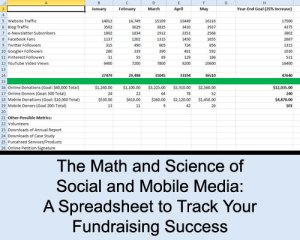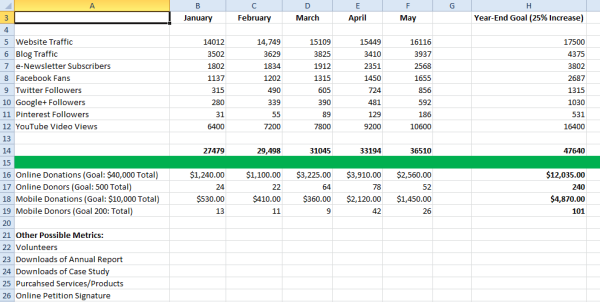 There absolutely is a math to social and mobile media. If your nonprofit has a good content strategy in place and understands the power of integrating all your nonprofit’s communications channels (website, email, Facebook, texting, etc.), then as your numbers grow on social networks so will your e-newsletter and mobile lists which in turn significantly increases your fundraising success. It’s a strategy that I have been using, testing, and adapting since @NonprofitOrgs first launched on Myspace in 2006 and now there’s an ever-increasing flow of data being released that proves that social and mobile media are, in fact, powerful fundraising tools.
There absolutely is a math to social and mobile media. If your nonprofit has a good content strategy in place and understands the power of integrating all your nonprofit’s communications channels (website, email, Facebook, texting, etc.), then as your numbers grow on social networks so will your e-newsletter and mobile lists which in turn significantly increases your fundraising success. It’s a strategy that I have been using, testing, and adapting since @NonprofitOrgs first launched on Myspace in 2006 and now there’s an ever-increasing flow of data being released that proves that social and mobile media are, in fact, powerful fundraising tools.
There is also a science to social and mobile media. After 10 years of experimentation, nonprofits are learning that there are correct (and incorrect) ways to post on Facebook, format a tweet, upload a photo, and send a text alert, but if your nonprofit doesn’t know the science, then math isn’t going to work.
For those of you who have read Social Media for Social Good and have taken my webinar on how to launch a social and mobile media strategy for your nonprofit, you know that the core of the strategy that I advocate for is tracking and proving your success. This is most easily done through a Social and Mobile Media Fundraising Success Spreadsheet.
[Download Spreadsheet Template]
Of course, a lot of factors can affect your success such as staff capacity and budget, the design of your online and mobile campaigns, and the skill set of your social and mobile media manager, but if your nonprofit has yet to start tracking your success (or lack thereof), download the spreadsheet, pick one day a month to enter your data, and begin to track your metrics. If your numbers do not grow from month to month, then something is terribly wrong with your content strategy (posting/sharing/sending the wrong content) and fundraising campaigns (not publishing an e-newsletter or using the wrong “Donate Now” service). That said, below is selection of metrics to track and a brief explanation as to why.
1. Website Unique Visitors
The foundation upon which all successful social and mobile campaigns are built is a well-designed, mobile compatible website.
2. eNewsletter Subscribers
Email is still a very powerful tool for fundraising and the likely reason why donor conversion rates dropped in 2012 is because nonprofit e-newsletters are still formatted to primarily be read on desktop and laptop computers. The number one activity on smartphones is reading email, so for your nonprofit to continue to be successful using email fundraising, a mobile compatible redesign of your e-newsletter should be at the top of your to do list.
3. Online Donations
Track the number of monthly donations and the total given. Understand that giving is higher in some months than others. November and December are the highest months and thus you will have to compare November 2013 to November to 2014, for example, to get the full picture of your fundraising success. As far as selecting the right “Donate Now” service, if the donation process occurs inside of your website and doesn’t send your donors to a third-party website, then you’re likely on the right path.
4. Blog Unique Visitors
Nonprofits that blog have a great advantage on social and mobile media because blogging allows your nonprofit to easily create a constant stream of fresh content that can be shared on social networks, incorporated into your e-newsletter, and texted to your mobile subscribers.
5. Social Network Followers
The brutal truth is that if your nonprofit posts boring content that does not inspire activity on social networks i.e., likes, shares, retweets, repins, and +1s, then your communities will grow very slowly. If you post too often or at the wrong times, then you’ll likely lose as many followers as you gain and your social networks will stagnate. This is especially true for small to medium-sized nonprofits.
As social media science clearly indicates, there is a right way to post and share content on social networks and a wrong way to post and share content on social networks. Silence speaks volumes on the Social Web and if your followers are saying little to nothing and are not liking, sharing, retweeting, repinning, or +1ing your content, then you’re are most likely doing it wrong. Rather than waste your time, get some good training and learn how to do it right.
6. Text Alerts Subscribers
Very few nonprofits are utilizing text alerts. Texting can be a powerful tool if it is done well, but annoying to supporters if it is not. However, unlike social media, pioneering mobile communications and fundraising is not “free” and over the last five years nonprofits have become very accustomed to free services. For those nonprofits wisely investing in the future, using social media and your website, e-newsletter, and print materials to build your mobile list is crucial.
7. Text-to-Give and/or Mobile Wallet Donors
Mobile fundraising is in its infancy and we’ve yet to see which tool will go mainstream, but my bet is on mobile wallet apps that are also web-based, such as Google Wallet. Google Wallet is currently only available to Android users, but if Apple launches an iOS wallet app that is also web-based, then that is the day that fundraising as the nonprofit sector has known it for 20 years instantly changes. Those nonprofits that pioneer mobile now will of course be in the best position to reap the benefits when mobile giving goes mainstream.
8. Other Metrics
Again, if your nonprofit has a good content strategy in place and understands the power of integrating all your nonprofit’s communications channels, then social and mobile media will also increase your success at recruiting volunteers, downloads of annual reports and case studies, online store sales, and online petitions.
How the Spreadsheet Works:
1. Create 13 columns of which 12 are for the 12 months of your fiscal year.
2. In the far left column, add the metrics you want to track. Under the green row, add your fundraising metrics.
3. At the beginning of each month, plot your metrics.
4. SUM your totals for monthly columns and annual rows.
5. On the far right hand column, plot your annual goals based on the first month’s metrics. A 25% increase is recommended for your first year.
6. If your social and mobile strategy is sound, then you should see an increase in your totals from month-to-month for website and blog traffic, e-newsletter and text alerts subscribers, and social network followers. However, because fundraising is seasonal, you won’t get a full picture of your fundraising success until you have tracked two years of metrics.
7. At the end of each year, revise your metrics and your goals. It’s that simple. 🙂
Related Links:
12 Must-Know Stats About Social Media, Fundraising, and Cause Awareness
11 Obvious Signs Your Nonprofit Needs Social Media Training
Social and Mobile Media Webinars for Nonprofits

